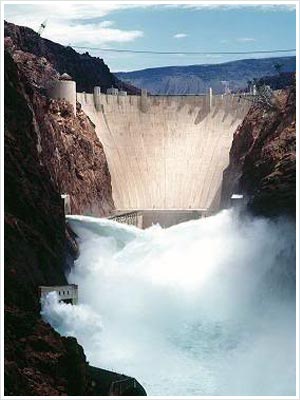Hydroelectric power
Hydroelectric power

Flowing water from streams or rivers has been used for many centuries to perform tasks such as driving mills and machinery. The principal of hydroelectric power is to use the force of moving water to drive an electric turbine and thus generate electricity. The water can either be sourced directly from a flowing river or artificial lakes or storage areas can be created at higher elevations and water can then be released only when electric power is required. This is an important feature of hydroelectric power because it means that electricity can be generated precisely when it is needed rather than when, for example wind and sunlight are available. Hydroelectric power is an established energy technology and has long constituted a significant proportion of the electricity generation mix in many countries.
A distinction is usually made between large-scale hydro (which usually involves the damming of whole rivers and the creation of large artificial lakes) and small-scale (or micro-) hydro. Micro-hydro usually refers to plants generating up to 100kW (or 100 standard units of electricity in an hour). They vary in size but may often just involve a small dammed pool, at the top of a waterfall, with several hundred feet of pipe leading to a small generator housing below. A single, large-scale hydroelectric power plant will generate a lot more power, but may have damaging environmental and social impacts.
Globally, large hydroelectric power plants provided 15 per cent of all the electricity produced in 2006.4 Far less than one per cent of all electricity derived from micro-hydro, but the current rates of growth in small hydro plants are much greater, especially in China where some five gigawatts of capacity is added annually; by 2005 some 58 per cent of the world’s small hydro plants were located in China.
In many countries, the construction of large hydro plants has stagnated because of serious concerns about damaging environmental and social impacts. The damming of rivers and creation of huge artificial lakes can have very adverse effects on existing wildlife and plants; the ecosystems of the rivers can also be severely damaged, and the people living in the area may have to move away from their homes to make way for the artificial lake. Micro-hydro on the other hand, when implemented well, has few or none of these environmental and social drawbacks. The use of micro-hydro also provides many more locations for power generation.
The debate about the relative merits of large-scale versus micro-hydro illustrates an important factor in the search for the best mix of renewable energy sources. We should not only look at the cheapest way of producing energy without contributing to global climate change: many other environmental and social factors have to be taken into account in making decisions about what mix of renewable energy sources will best suit our needs, source British Council, report August 2008
About us
Our company is a system integrator in the field of renewable energy. Our team is there for you to tailor your energy needs (from hot water and electricity) to your home, your factory, your hotel or your compound by using natural, Green and renewable sources of energy (sun, wind, waves and more) that best suit your application and your budget.
Our Philosophy
“Our hunger for energy is increasing day by day and therefore more CO2 emission and more damage to our grateful planet earth…the least we can do to save our environment is to be positive and proactive in relying on God’s renewable energy (sun, wind, waves, and more natural forces) instead of harmful sources (petrol, gas and the like) to generate our never ending need of energy”
Amr ELHUSSEINI, Founder & MD
Our Mission
Cleaner environment to our kids using smart renewable energy solutions meeting your energy needs



